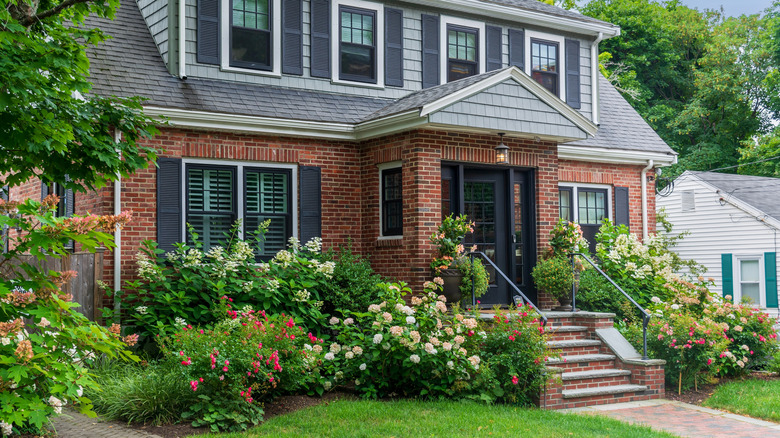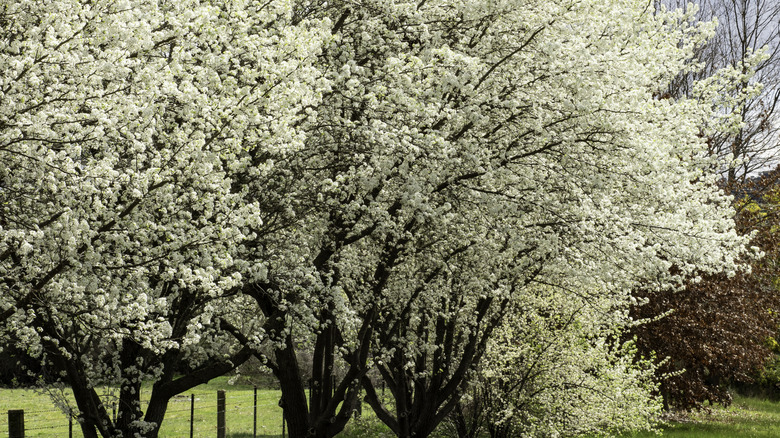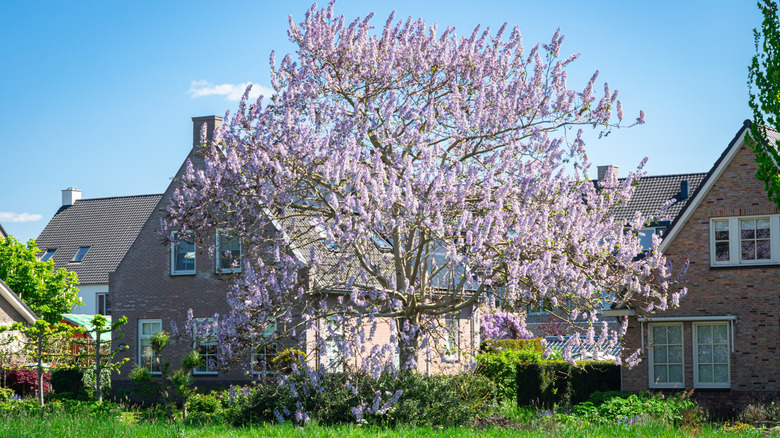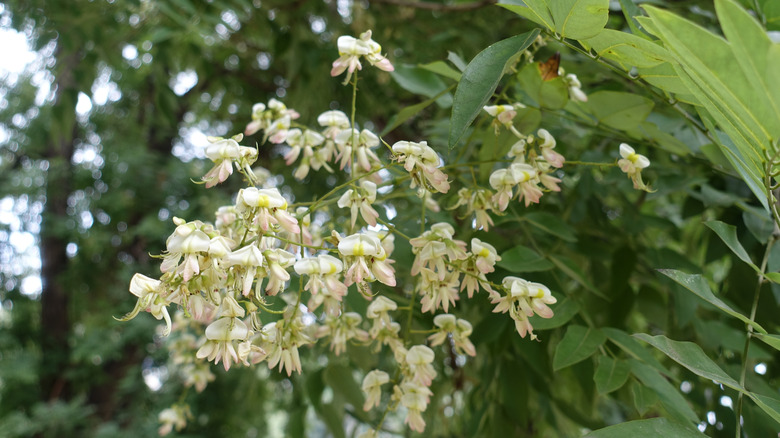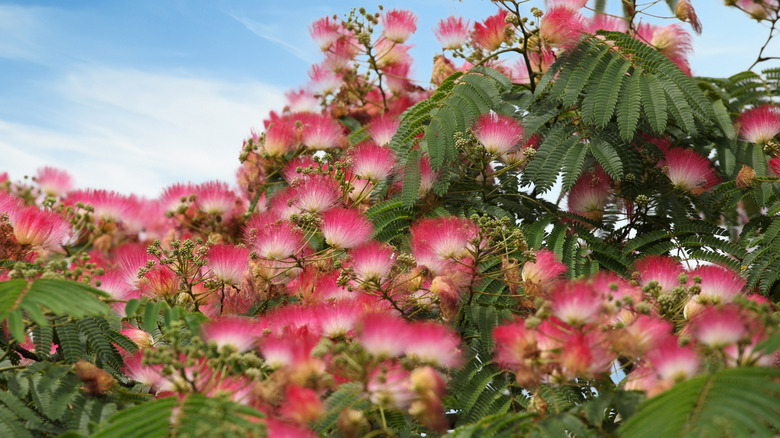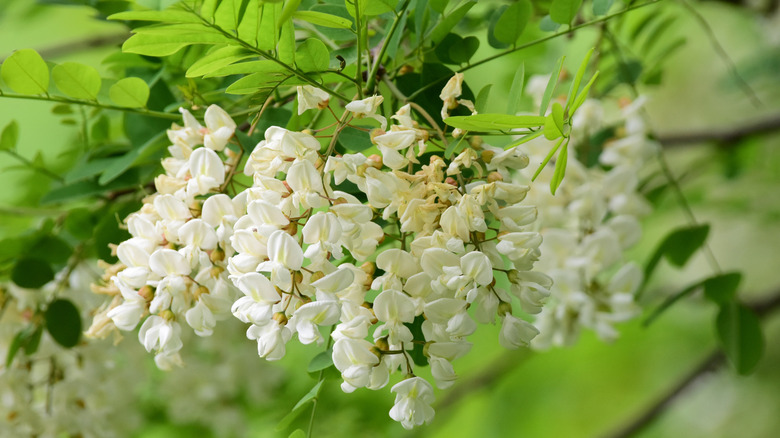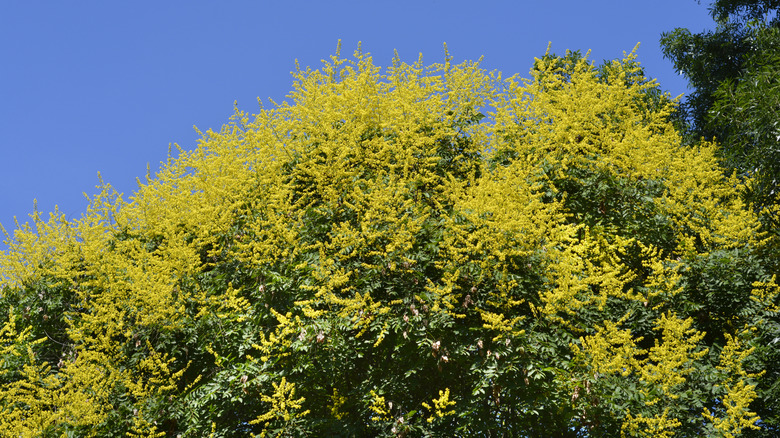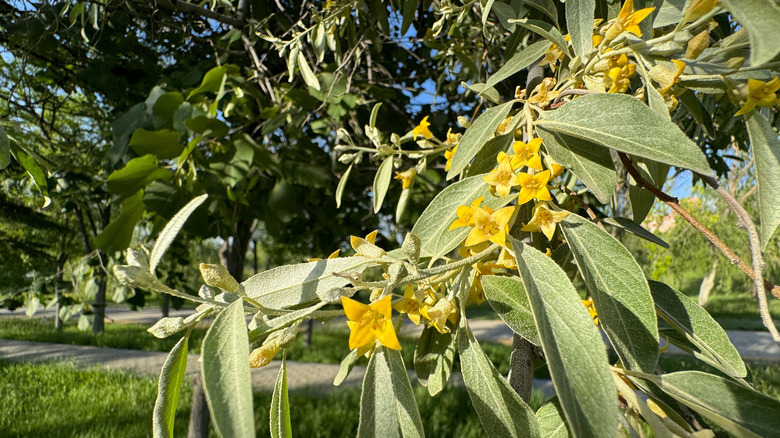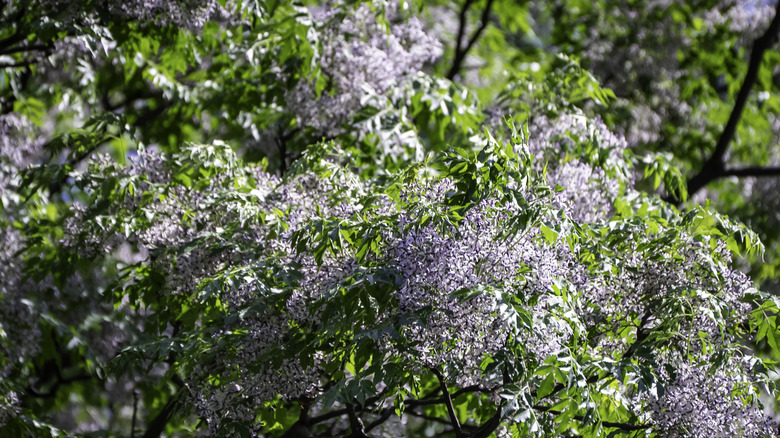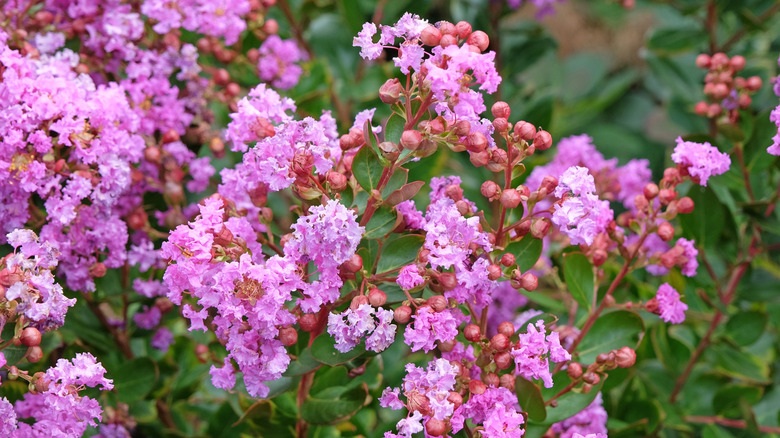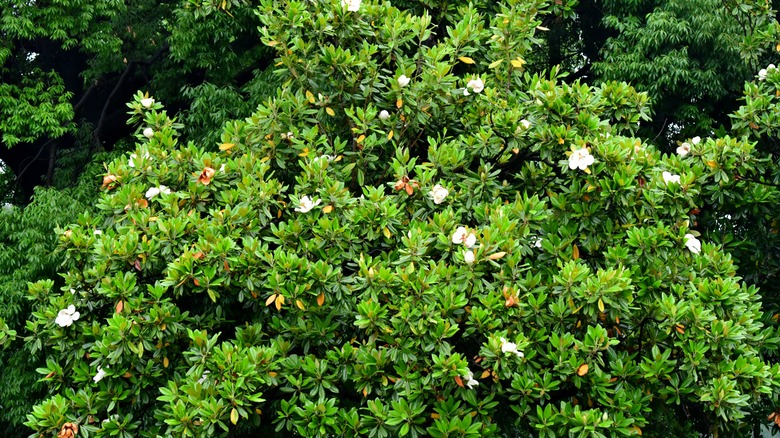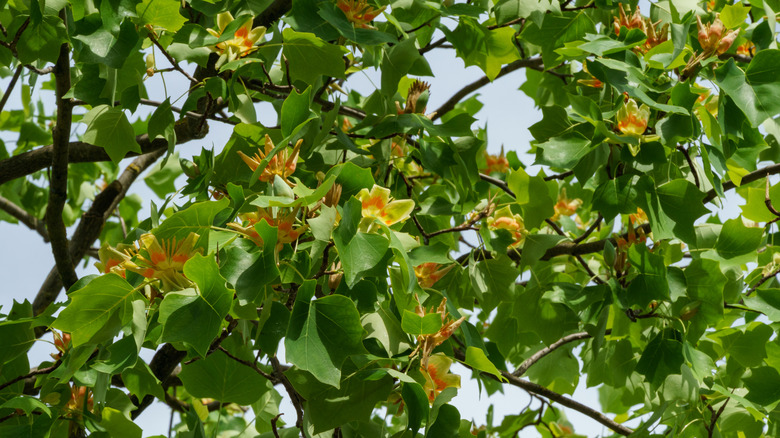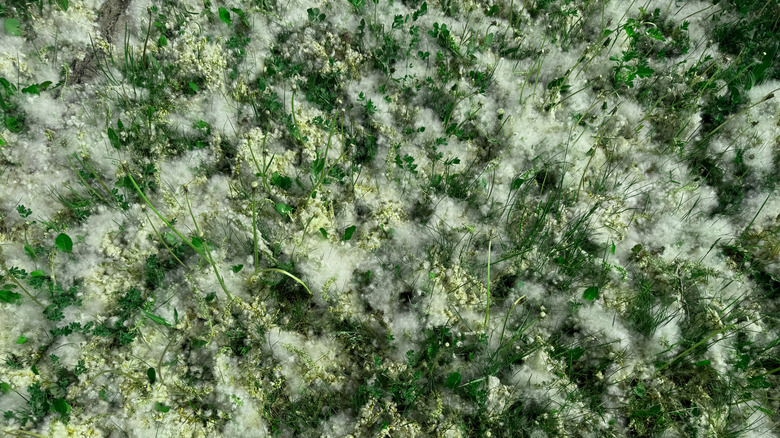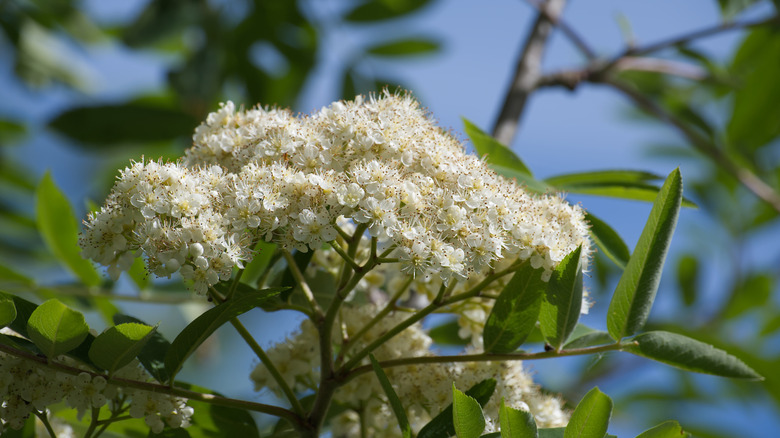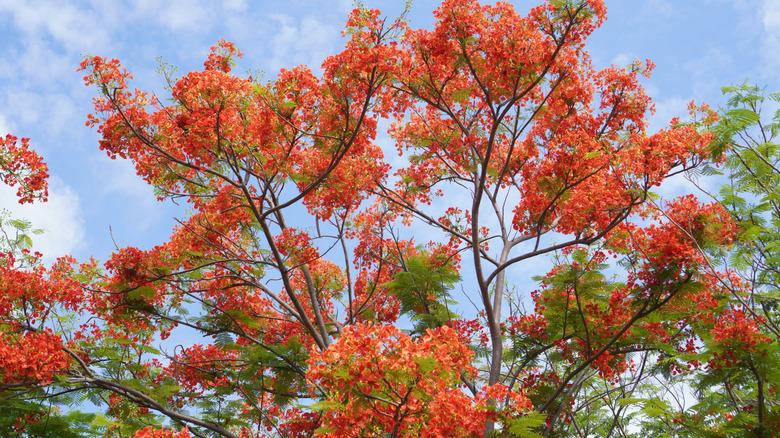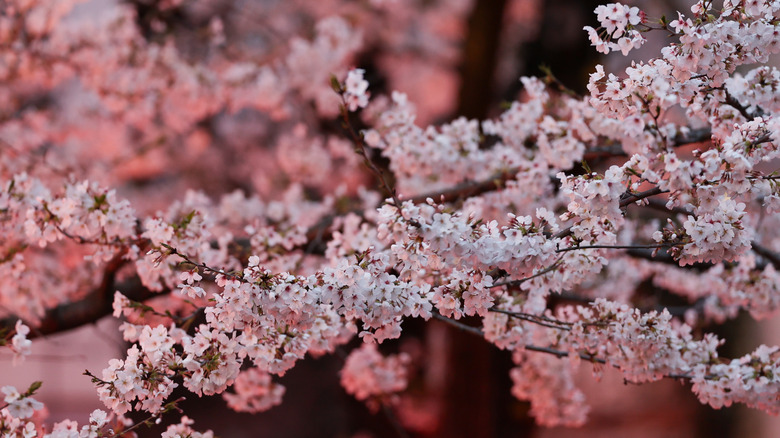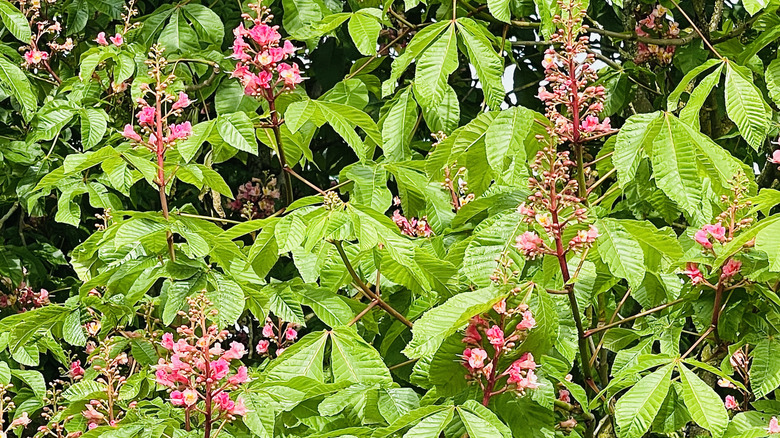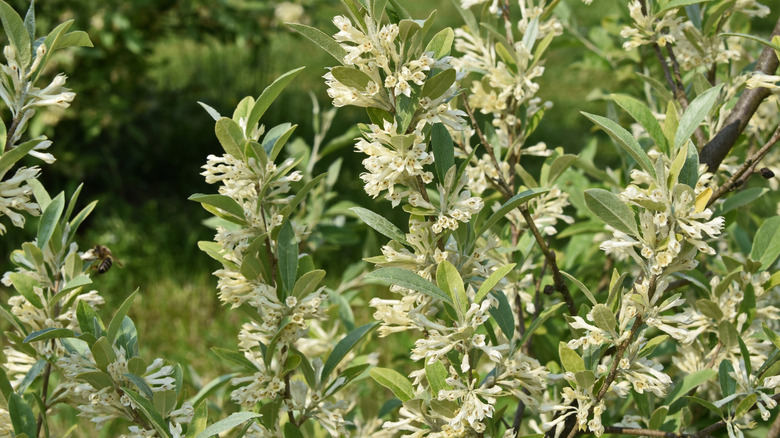18 Popular Flowering Trees That Aren't Worth Putting In Your Yard
When designing a landscape, many homeowners seek flowering trees that act as beautiful accents and give the space a visual lift. Unfortunately, not all popular tree offerings are up to the task and are visibly unsuited to typical residential landscapes. The reasons vary, of course, with some specimens becoming downright weedy, or worse, invasive in the territory — think tree of heaven, empress tree, mimosa tree, Chinaberry, and Russian olive, to name a few. Others, like Bradford pear and European mountain ash, become problematic due to their foul-smelling flowers.
Fast-growing trees often sacrifice strong structure for quick growth, so golden rain tree or black locust may be less desirable options unless you're prepared to spend time cleaning up dead limbs. Messy trees like southern magnolias and red buckeyes that strew the ground with litter, as well as pest-attracting trees such as tulip poplar and crape myrtles, fall out of favor because they are high maintenance.
To help you avoid years of frustration, labor, and costly removals, we've compiled a list of 18 popular flowering trees that, despite their ornate appeal, are not worth planting in your yard. Be sure to skip them on your next nursery visit, instead focusing on trees that offer a strong growth habit, decent pest resistance, and are preferably native to your area as they'll be naturally adaptive.
Bradford pear
Bradford pear (Pyrus calleryana 'Bradford') is a stinky tree you should avoid at all costs (or cut down if you already have one) in your yard. Although the white blooms adorning its dense foliage in early spring present a breathtaking sight, they emit a rotten smell, detracting from the overall experience. Additionally, these trees are weak-wooded and easily torn apart by winds and snow, requiring frequent maintenance or, worse, quick replacement because they don't survive for long. Worst still, Bradford pear trees are invasive across several U.S. states and should be avoided to protect the local ecosystem.
Tree of Heaven
Favored for its ornate beauty brought forth by the summer-borne greenish-gold flowers, tree of Heaven (Ailanthus altissima) is another flowering tree you must avoid. Both their flowers and leaves emit an awful odor. Moreover, they colonize in all sorts of conditions, including cracks and crevices, which can become problematic from a maintenance perspective. Such tendencies have earned it the tag of an invasive species across 30 U.S. states. Another problem is that tree of heaven supports spotted lanternflies, an invasive pest that actively feeds on grapes, apples, cherries, and other fruit trees.
Empress tree
Empress tree (Paulownia tomentosa) may feature as your favorite pick among trees that bloom with gorgeous purple flowers, but resist putting it in your yard. For starters, this tree may not bloom abundantly as spring frosts can damage the buds. Rapid growth creates brittle wood that splits easily, making it a liability in residential landscapes. Moreover, the empress tree is a prolific seed producer, thus easily turning weedy in the lawn. It isn't easy to remove either, given its tendency to sprout new root suckers. As a result, it's classified as invasive in several areas where it has outcompeted native vegetation.
Japanese pagoda tree
Even though the Japanese pagoda tree (Styphnolobium japonicum) is popular across residential landscapes for its shade and beauty, avoid planting them in your yard. These trees can take about a decade to begin bearing summer blooms, and when they do, these flowers, along with the fall-borne seedpods, create a mess when they're shed from the trees, staining the ground underneath. Japanese pagoda trees have weak branching patterns, which make them susceptible to limb breakage, especially if they've been left unpruned for a while. Also, this flowering tree has started to establish itself in the wild and has earned itself the invasive label in some U.S. areas.
Mimosa tree
In theory, silk or mimosa tree (Albizia julibrissin) could be an excellent addition, given its wide adaptability and the fragrant, summer blooms. However, its agreeableness to myriad conditions enables its aggressive spread within the landscape as well as wild areas that it escapes to through seeds. Even if you live outside the southeast U.S. region where the tree isn't yet labelled invasive, mimosa trees will spell trouble with their constant offloading of dead leaves and flowers that require significant cleanup. They're also prone to several pests and diseases, which can be fatal in some cases, necessitating early replacements.
Black locust
Black locust (Robinia pseudoacacia) enthralls its onlookers as well as a bevy of pollinators with its nectar-rich, highly-aromatic, white flowers that make an appearance toward spring's end. Yet, you should think twice before adding these trees to your yard. Despite being native to some parts of the U.S., black locust has earned the reputation of being a bully plant that has taken over wild areas across the continental U.S., especially the Midwest. It's also quite thorny, and its bark, foliage, and seeds contain toxic components that can be deadly to humans and their pets if ingested. Weak wood is another drawback.
Golden rain tree
An Asian import, the golden rain tree (Koelreuteria paniculata) is known for its yellow petals that are just as charming on the tree as they are on the ground after falling, creating a golden carpet below. Yet, you must resist planting these flowering trees in your yard. Assuming your tree isn't planted around a hardscape where the flower drop will pose cleanup issues, golden rain tree can effectively become weedy because of its self-seeding tendencies and is invasive in some areas. Since it's a fast grower, it doesn't produce strong wood, which can be an issue in windy or snowy areas.
Russian olive
Russian olive (Elaeagnus angustifolia) is popular for its silvery foliage and the highly-perfumed, buttery yellow flowers that show up between April and June. But you should avoid growing it, especially if you live on the west or East Coast where it's considered a highly invasive species. Besides outmaneuvering native plants from their designated sites and, by extension, the local birds dependent on their produce, Russian olive trees affect the area's resource profile by depleting the water resources. If you've planted them already, check to see if they're considered a noxious weed in your state and remove them accordingly.
Chinaberry
Fast growth, dense shade, and a chocolaty fragrance wafting from sprays of lavender flowers that also attract hummingbirds? No wonder chinaberry (Melia azedarach) trees are popular as ornamental shade trees. Unfortunately, they're invasive across many states or are subjected to restrictions where the onus falls on homeowners to ensure they don't spread beyond their yards. Chinaberry suckers profusely, thus establishing thickets that sideline native vegetation and the wildlife dependent on them. Lack of predatory insects teamed with allelopathy and the tree's easy adaptability further encourage its spread. Since they're difficult to eliminate, chinaberry trees aren't recommended for residential lots.
Crape myrtle
The rosy red flowers on crape myrtle (Lagerstroemia indica) trees may have your heart, but they can turn into a point of vexation once they drop on any hardscape elements or parked cars, staining them. Even when planted in an open location, crape myrtles can be a handful from the maintenance standpoint. They attract many pests, including aphids, that frequently excrete honeydew, adding to the nuisance, and often require homeowners to resort to heavy pesticide usage. Crape myrtle bark scales that reduce plant vigor and flowering quality are also becoming a major problem, especially in Tennessee.
Southern magnolia
The fragrant white blooms that remain on display from May through June may have you convinced that southern magnolia (Magnolia grandiflora) is indeed what you need next in your yard. But unless you have enough space to accommodate its 50-foot girth, know these trees will likely outgrow most yards. Plus, they aren't exactly hospitable to their kind, preventing other plants from rooting underneath their canopies. The low-growing limb growth also affects ground clearance, unless you cut them out regularly. Since southern magnolias drop their leaves both during spring and fall, apart from their fruits, they can generate a lot of objectionable ground litter.
Tulip poplar
Although tulip poplar (Liriodendron tulipifera) trees offer excellent benefits to the local pollinators and appear attractive when their yellow flowers are in bloom during the summer, they aren't ideal for most yards. Standard specimens can grow nearly 120 feet high, thereby dominating the space unless pruned regularly to a more manageable height. Besides that, they frequently fall prey to the mandibles of rabbits and a horde of aphids and scales that riddle the tree with sooty mold, negatively affecting its health. The non-stop flower, seed, and leaf litter is another negative, as is their brittle wood that comes loose during rains or storms.
Eastern cottonwood
Despite its wildlife value, native plant enthusiasts must resist adding eastern cottonwood (Populus deltoides) to their yards. This tree can grow an unwieldy size, touching 100 feet in height and half that in spread. Overall, it has a weak structure, which creates problems on windy or snowy days with the limbs breaking free of the tree. Leaves, flowers, and fruit catkins dirty the ground when they disconnect from the sentinel, requiring significant clean-up. Since eastern cottonwoods send across suckers, they spread into garden beds, unless you regularly pull out volunteer seedlings. Their roots can upend sidewalks or infiltrate sewage systems.
European mountain ash
European mountain ash (Sorbus aucuparia) or Rowan trees can look attractive year-round with their batch of spring blooms, red fruits, and multi-trunked form. Still, they might not be suitable for planting. This is in part due to their rotting fish-like odor. As their limbs grow vertically, they form weak connections that break off easily under pressure. Besides, they're susceptible to a host of diseases, such as bacterial fire blight and scab that can kill or defoliate the tree. They're also affected by mountain-ash sawfly, aphids, and scales that impair their growth and require chemical treatments. These invasive trees are also known to escape from cultivation.
Royal poinciana
Granted, royal poinciana (Delonix regia) offers unmatched beauty through their deep red or orange blooms during the growing season. But they aren't appropriate in most properties given their huge size. Royal poinciana grows wider than tall at 60 feet, and their canopies are so dense that most grasses struggle to survive underneath. Moreover, they develop shallow roots that can raise hardscape elements, such as pavements and driveways, if a suitable distance isn't maintained. Their 18-inch-long fruits create lots of clutter when they fall during spring. You'll also need to tirelessly prune the plant to maintain a strong structure.
Flowering cherry trees
Although flowering cherry trees (Prunus spp.) look spectacular when they're in bloom, their display is usually short-lived — lasting no more than a week — and is then replaced with a drab look for the rest of the year. What's worse is that these trees are also quite short-lived and may have to be replaced every 20 to 25 years. That's because they're quick to take damage as soon as they're exposed to environmental stressors, especially in wet climates or when planted in urban, compacted soils. This, in turn, makes them vulnerable to borers and fungal diseases.
Red buckeye
Those looking to grow native plants for a sustainable approach to attracting hummingbirds may have considered red buckeye (Aesculus pavia) as ruby-throated hummers enjoy their red flowers. However, you may have to reconsider this option if you have a restricted yard. Red buckeye's limbs droop to the ground, compromising on clearance. Also, they clutter the ground when they shed their leaves, flowers, and seeds. This can get dangerous around curious kids or pets as all their plant parts are highly toxic and can prove deadly on consumption. Red buckeyes are also susceptible to leaf blotch, which may lead to premature defoliation.
Autumn olive
Autumn olive (Elaeagnus umbellata) adds a touch of beauty in late spring or early summer with its perfumed, creamy-white flowers. But since the birds enjoy the red fruits that follow the blooms, these trees get to spread beyond their boundaries, owing to the seeds they expel after consumption. This has made them one of the most invasive trees on the East Coast to avoid planting at all costs. Even when they aren't classified as problematic in your area, you still might have to expend energy on weeding out new seedlings. Autumn olives are also not suitable in enclosed spaces where their thorns can become a prickly issue.
